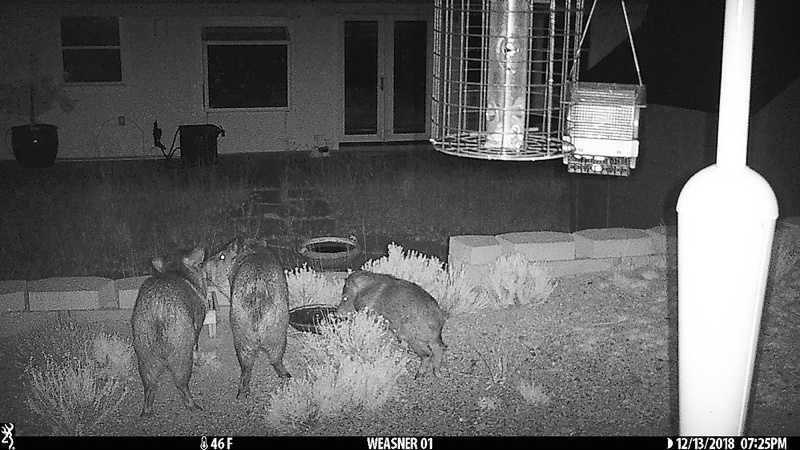Comet 46P/Wirtanen, Waxing Gibbous Moon
Posted: 19 December 2018
Cloudy skies returned on Friday, 14 December 2018. The cloudy nights meant that I missed out on prime viewing of Comet 46P/Wirtanen.
In my report on my session of 13 December I mentioned being harassed by some Javelinas. Our new wildlife camera provided evidence why they were not happy with me being outside:


Saturday, 15 December, had a pretty sunset with a Sun pillar:

The sky dawned clear on Monday, 17 December, but clouds returned mid-morning. Tuesday, 18 December, was finally mostly clear during the day and evening.
|
Open: Tuesday, 18 December 2018, 1812 MST Temperature: 61°F |
Session: 1316 Conditions: Mostly clear |
Equipment Used:
12" f/8 LX600 w/StarLock
2" 24mm UWA eyepiece
Focal Reducer
Camera:
D850 DSLR
1817 MST: LX600 ON, StarLock OFF, High Precision OFF.
Viewed Mars, 102X. No surface details visible, its gibbous phase was very obvious.
Then viewed the waxing gibbous Moon, 102X.
1830 MST: tried to view Comet 46P/Wirtanen with the naked eye and 12x50 binoculars. No joy. Even with knowing where to look, the sky brightness of the nearby Moon was too much and overwhelmed the faint comet.
SYNCed the 12" telescope on the star Aldebaran.
1836 MST: Meade Stella Wi-Fi Adapter ON.
Used SkySafari 6 Pro on my iPhone to GOTO Comet Wirtanen. Only the comet's nucleus was visible near a bright star in Perseus (HD1390).
Slewed back to Aldebaran, mounted the D850 DSLR at prime focus + focal reducer, focused on Aldebaran, and locked the 12" primary mirror. Used SkySafari to return to the comet.
1850 MST: Wi-Fi OFF, StarLock ON.
Due to the comet's expected rapid motion I used an exposure length of 30 seconds for this StarLock autoguided, ISO 6400, White Balance 4000K, image:

Next, I did a series of exposures (same settings) at 2 minute intervals to show the comet's motion. The top image is a merge of the five exposures; the bottom image is the animated version.


1904 MST: StarLock OFF.
I was surprised at how well the StarLock autoguiding performed as the sky was very bright from the Moon.
Slewed to the Moon and took this image (1/320sec, ISO 100, WB Auto, slightly cropped with increased saturation):

Then removed the camera and viewed the Moon, 102X.
1917 MST: LX600 OFF.
|
Close: Tuesday, 18 December 2018, 1927 MST Temperature: 49°F |
Session Length: 1h 15m Conditions: Mostly clear |
I have posted a review of the Astrozap Flexible Dewshield that I got after a recent session with a very rare dewed-over corrector plate on my telescope.
I have created a Edmund Scientific Telescopes Memorial Page. Check it out.
Comments are welcome using Email. Twitter users can use the button below to tweet this report to their followers. Thanks.
Cassiopeia Observatory Home Page
Copyright ©2018 Michael L. Weasner / mweasner@me.com
URL = http://www.weasner.com/co/Reports/2018/12/19/index.html
